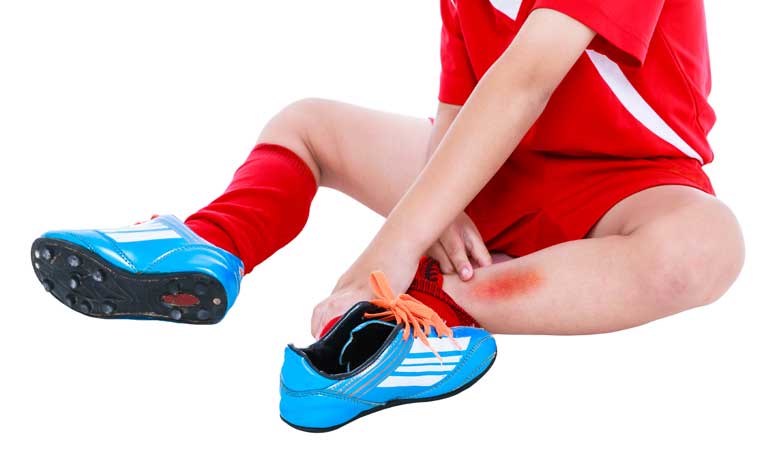
Sport injuries account for a quarter for all injuries in children and adolescents.
The incidence of sports injuries is increasing due to increasing participation in sports at all ages. "Prevention of sports injuries is aided by improved education of athletes, coaches and parents with regard to the specific requirements of the sport and the risks involved," say doctors from the Department of Orthopaedic Surgery at KK Women's and Children's Hospital (KKH), a member of the SingHealth group.
Soft tissue injuries
- Contusions – From direct trauma with intact skin, results range from haematomas to compartment syndrome in severe cases.
- Lacerations – From direct trauma with breach of the skin, commonly require washout and suturing.
- Sprains – Indirect stress injuries to joint capsules or ligaments. Requires bracing to allow proper healing. Severe cases require prolonged bracing and possibly surgery.
- Strains – Occurs in muscles and the myotendinous junction. Treatment is similar to that for sprains. Classic initial management of soft tissue injury is RICE or rest, icing, compression and elevation. This is most effective if applied in the early stages after an injury. Rehabilitation is key in allowing early return to function and sports.
Overuse injuries
- Rotator cuff tendonitis – Occurs with repetitive overhead activities or direct trauma to the shoulder such as contusion, dislocation or overload lifting. Symptoms include generalised shoulder pain, or pain which worsens with overhead activities or which affects sleep.
- Thrower’s shoulder and thrower’s elbow – Overuse injuries resulting from excessive throwing. Treatment for most injuries consists of rest, activity modification and a rehabilitation programme.
- Osgood Schlatter disease – Irritation and inflammation of the growth plate at the top of the shin bone where the patella tendon inserts. This condition occurs during periods of rapid growth. It is treated by stretching and strengthening exercises of the hamstrings and quadriceps, and through activity modification.
- Sinding-Larsen-Johansson syndrome, also known as Jumper’s Knee – It is the inflammation and irritation of the growth plate at the bottom of the patella, where the patella tendon inserts. This condition usually happens during periods of rapid growth. Treatment is similar to that for Osgood Schlatter disease.
- Sever’s disease – It is the irritation and inflammation of the growth plate at the back of the heel bone where the Achilles tendon inserts. Treatment consists of rest, ankle stretching and strengthening exercises and heel pads.
- Osteochondritis dissecans – This is a condition where the bone and adjacent cartilage loses its blood supply. It may affect the knee, ankle or elbow. Often visible on x-rays, but usually requires an MRI to delineate fully. Can be treated with bracing or casting initially, but larger lesions often require surgery, especially in older children.
- Stress fractures – Occurs following repetitive trauma to normal bone that is not conditioned to the stress. Commonly in the lower limbs and usually responds well to rest and gradual resumption of activity
Acute Injuries
- Shoulder dislocation – Usually occurs when the top of the humerus is sitting in front of the shoulder blade. There will be generalised swelling, loss of the normal shoulder contour as well as restricted arm movement. Axillary nerve injuries can occur. Injuries to ligaments such as Bankart or glenoid bone lesions as a result of the dislocation do occur.Treatment consists of putting the humerus back into place early (early reduction) and initial immobilisation, followed by range of motion and shoulder strengthening exercises. There is a 90 per cent recurrence rate in teenagers, leading to advice for surgical treatment such as early arthroscopic stabilisation of the shoulder.
- Patella dislocation – This occurs when the kneecap comes out of its normal position. A dislocated patella may reduce spontaneously – the kneecap goes back into its proper place on its own. It is treated with early reduction, immobilisation for a few weeks, then range of motion and strengthening exercises. Osteochondral fracture (cartilage covering end of bone is torn), patella maltracking (where the patella does not stay within the central grove of the thigh bone) or recurrent dislocation are indications for surgical repair of the medial patellar stabilisers or distal realignment procedures.
- Anterior cruciate ligament (ACL) injuries – Associated with a ‘pop’ sensation during injury and knee swelling, with difficulty bearing weight. It is diagnosed with anterior drawer, Lachman and pivot shift tests. MRI aids visualisation of injury and concurrent meniscal or ligament injuries. Non-operative treatment includes bracing of the knee, restoration of range of motion, strengthening the quadriceps and hamstrings, and activity modification. Most children are unable to restrict activity and hence require operative reconstruction of the ACL.
- Meniscal injuries – Frequently associated with ACL injuries, tibial eminence fractures and chondral injuries. May present with pain, swelling, stiffness, instability, clicking, locking or popping of the knee joint. MRI is helpful for assessment. Requires operative repair to prevent further injury to the meniscus and cartilage.
Ref: U11
Contributed by


















 Get it on Google Play
Get it on Google Play